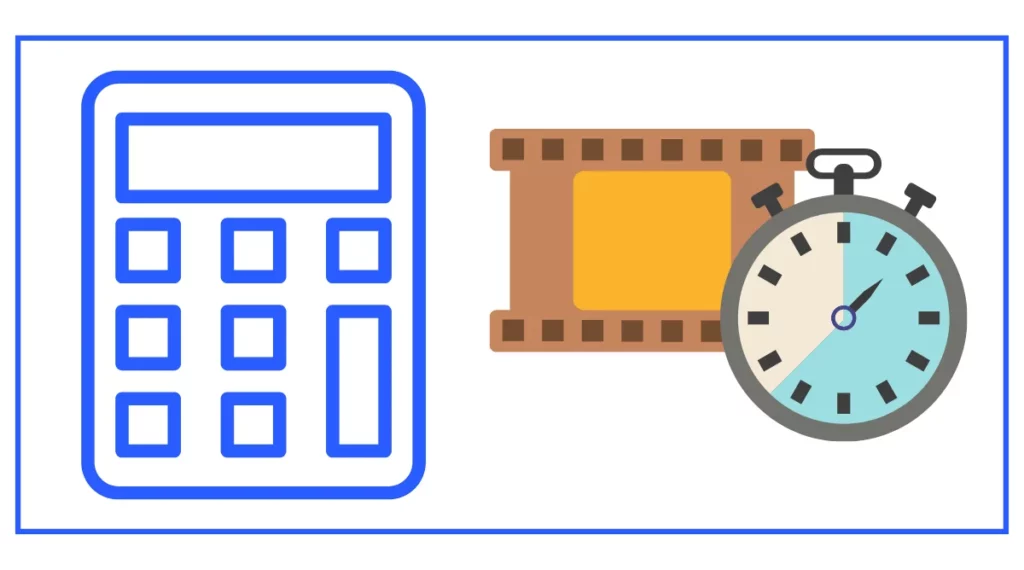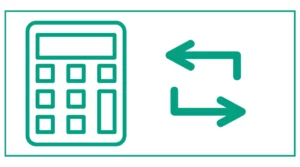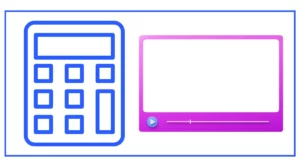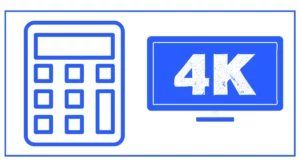Frames To Timecode Calculator
Are you a camera assistant?
Do you want to convert the frames to a timecode?
The frames to time code ( or you can say TC) calculator allows you to convert the frames to time code in a recorded video.
To use this converter, all you need to do is to enter the number of frames and the frame rate. Hit the calculate button. You will be able to find the timecode in hours, minutes, and seconds.
The timecode helps you mark the beginning and end of a scene. You might want to calculate the resolution or video size,

Timecode is a crucial element in video editing and production, serving as a precise method to identify and synchronize specific frames within a video sequence. For video editors and professionals working with moving images, understanding how to convert frames to timecode is an essential skill. This guide will introduce you to the concept of timecode, explain its importance, and provide a detailed walkthrough of using a frames to timecode calculator.
What is Timecode?
Timecode is a sequence of numeric codes generated at regular intervals by a timing system. It is used in video production, filmmaking, and other multimedia applications to provide a precise time reference for each frame of video. The standard timecode format is typically represented as HH:MM:SS:FF (Hours:Minutes:Seconds:Frames).
Understanding Frame Rates
Before diving into timecode conversion, it’s crucial to understand frame rates. Frame rate, measured in frames per second (fps), refers to the number of individual images displayed in one second of video. Common frame rates include:
- 24 fps: Often used in motion pictures
- 25 fps: Standard in PAL video systems
- 29.97 fps: Common in NTSC video systems
- 30 fps: Used in some high-definition video formats
- 60 fps: Utilized in high-frame-rate video and gaming
The Importance of Timecode in Video Editing
Timecode plays a vital role in video editing and post-production processes. It allows editors to:
- Precisely locate specific frames within a video sequence
- Synchronize audio and video elements
- Coordinate multiple cameras in multi-camera shoots
- Accurately track and manage edit decisions
- Facilitate collaboration between different departments in post-production
How to Use a Frames to Timecode Calculator
A frames to timecode calculator is a tool that converts a given number of frames to its corresponding timecode based on the specified frame rate. Here’s a step-by-step guide on how to use this calculator:
- Input the total number of frames you want to convert
- Specify the frame rate of your video (e.g., 24 fps, 29.97 fps, 30 fps)
- Click the “Calculate” button
- The calculator will display the result in the standard timecode format (HH:MM:SS:FF)
Example 1: Converting Frames to Timecode at 24 fps
Let’s say you want to convert 1440 frames at a frame rate of 24 fps:
- Enter 1440 in the “Frames” field
- Enter 24 in the “Frame rate” field
- Click “Calculate”
- The result will be 00:01:00:00 (1 minute)
This calculation shows that 1440 frames at 24 fps equals exactly one minute of video.
Example 2: Converting Frames to Timecode at 29.97 fps
Now, let’s convert 5400 frames at 29.97 fps:
- Enter 5400 in the “Frames” field
- Enter 29.97 in the “Frame rate” field
- Click “Calculate”
- The result will be 00:03:00:03
This calculation demonstrates that 5400 frames at 29.97 fps equals 3 minutes and 3 frames.
Advanced Timecode Concepts
Drop-Frame vs. Non-Drop-Frame Timecode
When working with NTSC video systems (29.97 fps), you may encounter two types of timecode: drop-frame (DF) and non-drop-frame (NDF).
- Non-Drop-Frame Timecode: This is a straightforward count of frames, where each frame is numbered sequentially.
- Drop-Frame Timecode: This method skips or “drops” certain frame numbers to compensate for the slight discrepancy between 29.97 fps and 30 fps. It helps to maintain accurate time measurement over long durations.
The frames to timecode calculator typically uses non-drop-frame timecode. For precise drop-frame calculations, you may need a more specialized tool.
Timecode Conversion Between Different Frame Rates
Sometimes, you may need to convert timecode from one frame rate to another. This process, known as frame rate conversion, can be complex and may require additional tools or calculations. When converting between frame rates, it’s important to consider:
- The original frame rate
- The target frame rate
- Whether the video will be speed-adjusted or resampled
For example, converting from 24 fps to 30 fps might involve repeating certain frames or using more advanced interpolation techniques.
Practical Applications of Frames to Timecode Conversion
Understanding how to convert frames to timecode is valuable in various scenarios:
- Editing Precision: When you need to locate a specific frame in a long video sequence, converting frame numbers to timecode can help you navigate more efficiently.
- Animation and VFX: Animators and visual effects artists often work with frame numbers. Converting these to timecode helps in syncing their work with the main video edit.
- Sound Design: Audio professionals may need to align sound effects or music cues with specific video frames. Converting frame numbers to timecode facilitates this process.
- Quality Control: When reviewing footage or final edits, being able to reference exact frames by their timecode is crucial for providing precise feedback.
- Archiving and Cataloging: Frame-accurate timecodes are essential for creating detailed logs of video content, which is valuable for archiving and future reference.
Tips for Working with Timecode
- Always double-check your frame rate: Ensure you’re using the correct frame rate for your project to avoid synchronization issues.
- Be consistent: Use the same timecode system (drop-frame or non-drop-frame) throughout your project to maintain accuracy.
- Use timecode generators: For recording, consider using equipment with built-in timecode generators to ensure frame-accurate timecode from the start.
- Familiarize yourself with different timecode formats: Some systems may display timecode differently (e.g., HH:MM:SS:FF vs. HH:MM:SS.frames).
- Practice mental math: While calculators are helpful, being able to quickly estimate timecode conversions in your head can be a valuable skill.
Conclusion
The frames to timecode calculator is an indispensable tool for video editors, filmmakers, and anyone working with time-based media. By understanding the relationship between frames, frame rates, and timecode, you can work more efficiently and precisely in your video production projects.
Remember that while this calculator provides a quick and easy way to convert frames to timecode, it’s also important to understand the underlying principles. This knowledge will help you troubleshoot issues, communicate effectively with team members, and make informed decisions throughout the post-production process.
Whether you’re syncing audio, coordinating with VFX teams, or simply trying to locate that perfect frame in a sea of footage, mastering timecode conversion will undoubtedly enhance your workflow and productivity.





